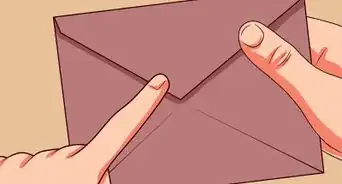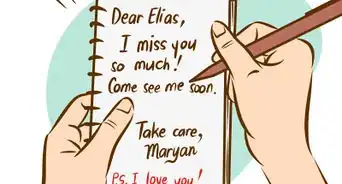This article was co-authored by Tami Claytor. Tami Claytor is an Etiquette Coach, Image Consultant, and the Owner of Always Appropriate Image and Etiquette Consulting in New York, New York. With over 20 years of experience, Tami specializes in teaching etiquette classes to individuals, students, companies, and community organizations. Tami has spent decades studying cultures through her extensive travels across five continents and has created cultural diversity workshops to promote social justice and cross-cultural awareness. She holds a BA in Economics with a concentration in International Relations from Clark University. Tami studied at the Ophelia DeVore School of Charm and the Fashion Institute of Technology, where she earned her Image Consultant Certification.
There are 9 references cited in this article, which can be found at the bottom of the page.
wikiHow marks an article as reader-approved once it receives enough positive feedback. In this case, 80% of readers who voted found the article helpful, earning it our reader-approved status.
This article has been viewed 2,604,158 times.
Even in today’s fast-paced world of text messages and instant communication, there are still plenty of reasons to send a traditional letter every once in a while. Thankfully, the entire process is incredibly simple and straightforward, meaning you can focus most of your attention on the contents of the letter itself.
Steps
Getting the Letter Ready to Mail
-
1Choose an envelope. It's important to find the right envelope for your letter. If you choose an envelope of very light construction, for example, any heavy contents might break through the envelope while it's in transit. Take the following factors into consideration as you choose an envelope:
- The weight of the paper. The weight of the envelope should be appropriate for the weight of the paper and any other contents you may be mailing. If your letter is written on heavy cardstock, or you're including something else such as photos, choose a sturdy envelope that can handle the weight enclosed.[1]
- The size of the envelope. The envelope's size should be appropriate for the size of the contents inside. Letters written on standard 8½-by-11-inch paper are typically folded into thirds and mailed in business-size envelopes. Letters written on notecards may be mailed in smaller envelopes.[2]
- The intent of the letter. If you're mailing a cover letter, you'll want to choose a professional-looking, business-size envelope. A personal note may be sent in a colorful, decorative envelope if you wish.[3]
- The letter's destination. If you're mailing a letter overseas, you may want to use a sturdier envelope, since there is a greater chance it could get damaged along the way.
-
2Enclose the letter and seal the envelope. Once you've chosen the envelope for your letter, place the letter inside and lick the edge of the envelope to moisten the glue, then press it shut to seal the letter.
- You can wet a sponge with a little water to moisten the envelope glue if you don't want to lick it.[4]
- Place a small amount of clear tape along the edge of the seal if you are afraid the letter might open on its journey.
Advertisement -
3Address the envelope. Write the address of the recipient in the middle of the front of the envelope. Include the recipient's name, apartment or house number, street name, city, state or province, and zip or postal code. Use the nine- or eleven-digit zip code if you know it. You may use the two-letter postal code for the state if you wish. Use clear, printed, upper-case letters written in dark ink so that any postal employee will be able to read your writing quickly and accurately.[5]
- If you are writing a formal letter, make sure to include the recipient's title and, if relevant, the name of the company.
- If you are writing to someone outside your country, make sure you include the destination country's name in upper-case letters at the bottom of the address.
- Some people have their mail sent to a post office box rather than a street address. If this is the case for your recipient, write the correct post office box number followed by the city, state and country, if applicable.
- Write each part of the address on a different line to make it more legible. For example[6]
:
- SKYLER WHITE
- 2004 ROSETHORN COURT APT 4
- ALBUQUERQUE NM 87041
-
4Write your return address. In the top-left corner of the envelope, write your name and address. For ease of postal handling it is better to write your return address on the front of the envelope rather than the back.[7] You may also use a printed return-address label. Including your address will ensure that the letter comes back to you if for some reason it doesn't make it to the recipient.
Finding the Right Postage
-
1Use a first-class stamp. If you're mailing a letter of standard size weighing less than an ounce and addressed to a U.S. address (including an APO or FPO address), place one first-class stamp in the top-right corner of the letter. Stamps are available for purchase at any post office, online at USPS.com, and at various retail stores.[8]
- Stamps come with either standard or special designs. If you want to purchase a decorative or commemorative stamp, go to a post office and ask to see their selection.
- Stamps rise in price periodically. If you have old postage stamps, check usps.com to make sure the stamps you have will still cover the full cost of first-class postage. You may have to use more than one stamp.
-
2Buy extra postage. Letters that are heavy or oversized and letters that are being mailed overseas require extra postage to reach their destination. USPS.com displays all current postage rates.
- If you have an accurate postage scale at home, you can weigh and measure your letter to determine how much postage you'll need to pay. Record the measurements, then check USPS.com for rates. Affix the appropriate postage to the top-right corner of your letter.
- If you don't have a scale, take your letter to a post office to have it weighed. The clerk will be able to calculate exactly how much postage you'll need.
Mailing the Letter
-
1Place the letter in a blue collection box. If you live in the United States, you'll notice blue USPS mailboxes in most cities and suburbs. Open the box near the top, place your letter in the slot, and close it. A postal worker will collect your letter at the time shown on the box and start the sorting-and-delivery process.
- Every blue collection box has a notice indicating when the mail gets picked up each day. If you place your letter in the box after the scheduled pick-up time, your letter will be picked up the next business day.[9]
-
2Place the letter in your own mailbox. If you have a mailbox on or near your home, you can place your letter there. Alert your mail carrier of its presence by moving the red flag out of the mailbox. This is usually done by rotating the flag up or by pulling the flag out. The mail carrier knows that if the flag is visible, then there is a letter that needs attention.
-
3Take the letter to any post office. If you need to buy postage, you can leave your letter with a postal clerk, and they will mail it for you. Even if you don't need to buy postage, you can still take your letter to the post office to be mailed.
- See www.usps.com for information on where to find the closest post office.
Community Q&A
-
QuestionAt what time should I put the envelope in my personal mailbox?
 Community AnswerYou should put it there before the day's mail is delivered, and be sure to put the "flag" up. This way the carrier will know that you have outgoing mail and stop to pick it up even if s/he doesn't have mail for you.
Community AnswerYou should put it there before the day's mail is delivered, and be sure to put the "flag" up. This way the carrier will know that you have outgoing mail and stop to pick it up even if s/he doesn't have mail for you. -
QuestionIs it free to mail a letter?
 Community AnswerNo. In most countries, regular sized letters/postcards cost a minimal fee to mail; this fee is represented by a postage stamp, which you can purchase from your local post office. Stamp prices can vary, but if you are sending a domestic letter that weighs under one ounce (this applies to the U.S. only), a letter only requires one stamp to send.
Community AnswerNo. In most countries, regular sized letters/postcards cost a minimal fee to mail; this fee is represented by a postage stamp, which you can purchase from your local post office. Stamp prices can vary, but if you are sending a domestic letter that weighs under one ounce (this applies to the U.S. only), a letter only requires one stamp to send. -
QuestionWhen will my letter arrive from England?
 DonaganTop AnswererInternational mail usually takes a week or longer to be delivered.
DonaganTop AnswererInternational mail usually takes a week or longer to be delivered.
Warnings
- Keep in mind what cannot be mailed. Explosives, batteries, oils, paints, and many other products are not safe to mail because it has the potential to leak in the changing pressures. Knowingly sending these packages in the mail is illegal and can earn you jail time or excessive fines.[10]⧼thumbs_response⧽
Things You'll Need
- Letter
- Envelope
- Pencil/Pen
- Stamp(s)
References
- ↑ https://pe.usps.com/text/dmm300/601.htm
- ↑ https://pe.usps.com/businessmail101?ViewName=Letters
- ↑ https://pe.usps.com/text/dmm100/tips-measure-letters.htm
- ↑ https://www.creationsbykara.com/how-to-seal-an-envelope-without-licking-it/
- ↑ https://pe.usps.com/text/dmm100/addressing-mail.htm
- ↑ https://pe.usps.com/businessmail101?ViewName=DeliveryAddress
- ↑ https://pe.usps.com/text/dmm100/addressing-mail.htm
- ↑ https://www.usps.com/business/prices.htm
- ↑ http://about.usps.com/postal-bulletin/2011/pb22313/html/updt_002.htm
About This Article
To get a letter ready for shipment, write the recipient’s name and address in the center of the envelope, followed by a return address in the top-left corner. If your letter weighs less than 1 ounce and is going to a US address, place a first-class stamp in the top-right corner of the envelope. For heavier packages and letters going overseas, check with USPS for recommended postage options. To learn how to mail your letter from a post office, collection box, or even your own mailbox, read on!
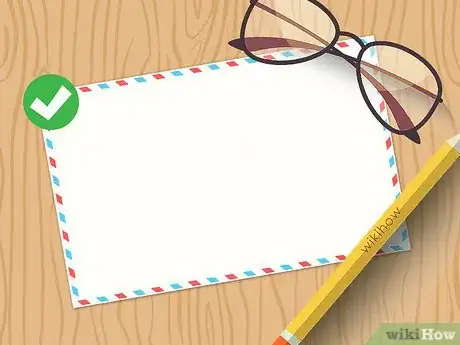
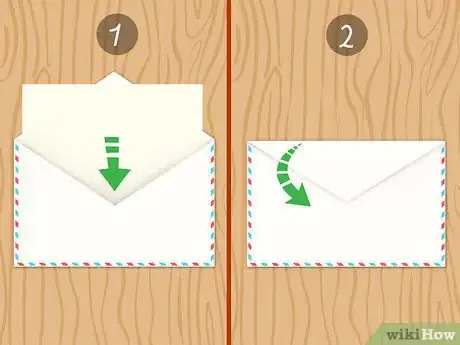
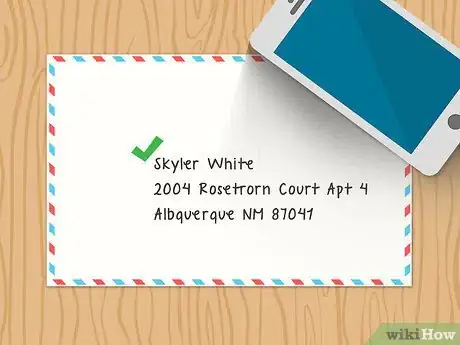

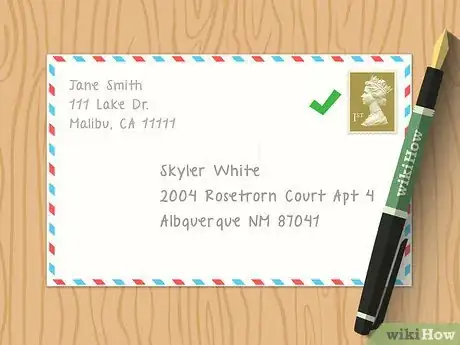
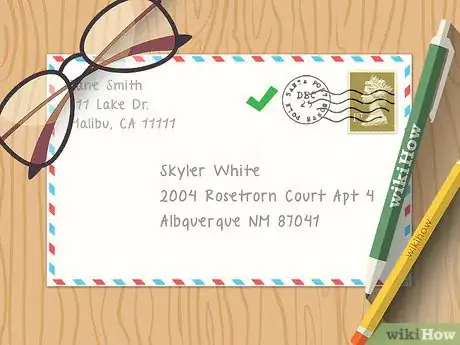

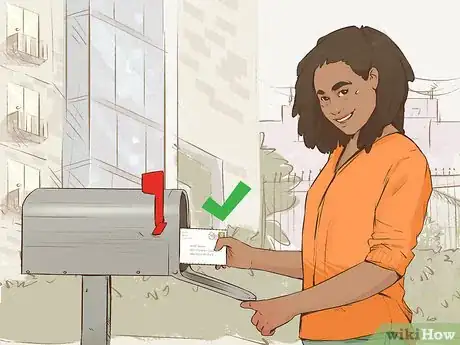
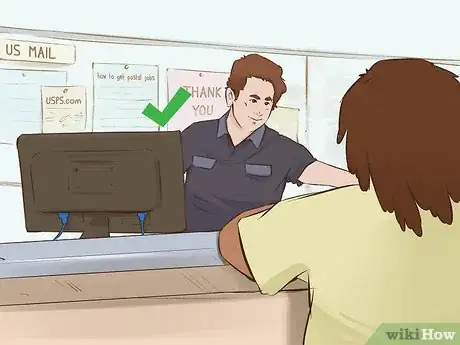





-Step-10.webp)





